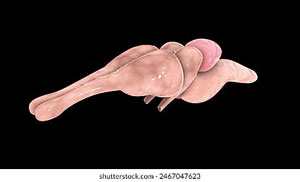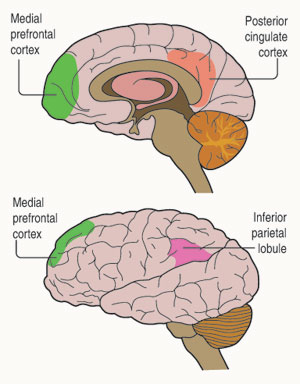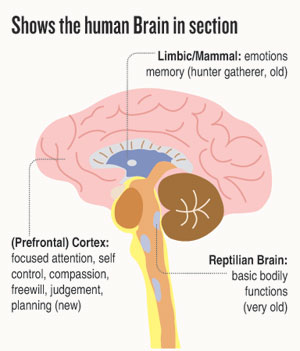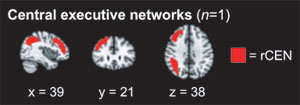Sunday Times 2
From Atta to Anatta: Lifting the ‘protective veil’ to taste liberation
View(s):By Dr Channa Ratnatunga
The I and the narrative Me, the prime actors of the Conditioned Self, need to be attenuated by a persistent meditative effort. The Conditioned Self is a natural phenomenon that is seeded in all mankind after birth to overcome all challenges and vicissitudes that life on Earth entails. Also included in this inherited security network is the primordial brain and its reflexes for survival and procreation.

Fig:1, Brain of a Reptile(Lizard)
This protective process has now been shown up by neuroimaging studies—Functional Magnetic Resonance Imaging (fMRI)—to be constantly impacting the neuronal networks of the human brain. The changes so effected are referred to as being due to neuroplasticity. It is, however, an intrinsic process in the brain and continues transforming the brain from childhood to death. This is the Conditioned Self—the Atta in Buddhist philosophy. It is not a permanent underlying entity or godhead commonly referred to as the soul but a process installed in the brain by evolution (i.e., nature).
Evolutionary biology of the human brain
The human brain reflects its biological antecedents in evolutionary history. As such, ensconced at its base are two primitive components, the reptilian and pre-mammalian brain (see Figs. 1 and 2). These parts of the brain are responsible for the primordial instinctual responses for survival and procreation. The former looks for food security, secures its need to allay thirst and ensures thermal security, and the latter seeks priority to procreative acts. Further, navigational memory to secure food and fluids too would naturally be part of it. Threats from predators and instincts to decide which is wiser, to ‘Fight or Fly’, are also an integral part of this basal brain. Once evolution proceeds to move forwards from the egg stage to a period of gestation and harbouring one’s young, as seen in mammals, the family is born. This entails protection of its young and the emotions that follow. The limbic system of the brain (See Fig: 2) is so evolved.
The combination of primitive instincts for survival, procreation and emotional needs implies that this primordial base exists in all mortals. It’s here that emotions hold sway, and unwholesome Kamma is committed if ‘the personal space’ is intruded upon.
The Mechanism ‘How’ to transform Atta to Anatta
The Conditioned Self is added to the predilections of the basal brain from birth. In a sophisticated society, to which we belong today, the Conditioned Self is born with this base and nurtured to a quality of the mind, in keeping with one’s experience that follows. The Conditioned Self is the Freudian psyche (Id-Ego-Super Ego)—the Atta in Buddhist philosophy, its negation—i.e., Anatta is the Dhamma’s greatest task. A difficult task, as it is a natural process of the brain (neuroplasticity) and has to be negated by mental means. This is done by mindful meditation. Hence, in effect, to rid the Atta—the Conditioned Self, of its kammic predilection, Insight Meditation (Vipassana) becomes a sine qua non.
Scientific clues of the effectiveness of this approach are now heralded by neuroimaging studies with fMRI on Tibetan monks, brought with the Dalai Lama’s patronage to the Waisman Centre at the University of Wisconsin, USA. They, who have had greater than 10-30,000 hours of Vipassana (Insight) meditative experience, were scanned by fMRI while meditating. The non-meditative controls (to compare) were average human beings, matched for age. Like most humans, they, the latter, spent most of their time in introspection, i.e., self-referential thinking, the mind wandering in general, jumping from one thought to the next with amazing speed and apparent randomness, ruminating about the past and worrying about the future. In the latter group (controls), the fMRI shows that they are dominantly in the Default Mode Network of the brain (DMN) located mostly in the medial prefrontal cortical areas of the brain (see Figa: 3a&b).
However, the fMRI of the monks, living in the ‘Now’, with focused attention, use another network of the brain called the Central Executive Network (CEN-See Figs:4a&b) which is the task-related network located in mostly in the Dorsolateral prefrontal cortical areas of the brain.
Those Tibetan monks who have achieved such a ‘quality of mind’ were persistently in the CEN. It had become a ‘trait’ as different from a mere transient ‘state’. It has also been shown by fMRI studies that living persistently in the ‘Now’, Trait (i.e., CEN), the CEN attenuates the DMN. That is how Atta is suppressed—Anatta (No-Self). The Atta—the Conditioned Self—has a predilection to generate Kamma; Anatta not so.

Fig. 3b: The fMRI images of the DMN-brain
What provokes bad Kamma
The limbic system of the human brain is associated through its connections to the Default Mode (neuronal) Network (DMN) of the brain with emotional sequences such as suspicion, irritation, annoyance, blame, anger, hatred, rage and revenge, or ruminating on ill will—jealousy, gossip, slander and lies or anxiety, fear, stress, fatigue, depressive tendencies, neuropsychiatric disorders, etc.; these are parts of the survival kit of man.
Getting some kind of priority in reproductive rights while living within a group, too, could evoke such emotions. Protecting the newborn is one of the many ‘issues’ that can provoke emotions. It also includes other triggers, such as tribalism, as found in its protean manifestations from loyalty to nationality, race, beliefs, and institutions, through to what is seen on the sports field. They are all included in this emotional category and manifested in the Conditioned Self.
Hence, emotions are consequent to the perceived violations of one’s personal space (i.e., boundaries, values), which are important to the Self so constructed by neuroplasticity. Which in turn are essential for survival in challenging social environments. Hence, survival, the Conditioned Self (the Atta), the DMN and ‘bad’ Kamma are inclusively related.

Fig: 4b –The fMRI images of the CEN-Brain
The Dhamma and the Arahath Mind
A huge quantity of information becomes available to the brain at any instant because the five sensory organs are continuously acting in parallel. This high demand needs interpretation to select on a priority basis, which is the threat to survival. As such, attention/contact (phassa) operates by selecting the most relevant information and filters out that which is irrelevant.
What the Self perceives is coloured by the nature and nurture of the individual, the upbringing, the defects and limitations of his sense organs, past emotional experiences of a similar stimulus, the limitations of his/her language, etc. The response of the individual by thought (intention), word and deed (papanca sankhara), etc., leads to Kamma. The response quality is pre-determined by the Conditioned Self.
The Arahath mind has cast off thoughts on ‘narrative me and the I’ (attachment to family, friends, profession, talents, achievements, ownership, e.g., possessions, businesses, bank accounts, etc.). Clinging to them would be the last baggage to be cast off, freeing the Conditioned Self of all its links with the shrinking personal space. This is to free the conditioning from birth and see reality without the lens of conditioning the ‘narrative me and the I’.
Hence, the Arahath mind, conditioned as it is by years of insight meditation, i.e., the CEN-trait, is unreactive, as different from a Conditioned Self. Ignorance is the key difference. Perception (Sanna) is not distorted by survival instincts in the Arahath Mind—which sees true reality, which would say, when under threat, ‘this response is a part of my survival instinct’.
Hence, in the ignorant being, the Conditioned Self (DMN – Atta) will continue to generate Kammic Forces. This reality will, by the natural law of conditionality (Paticca Sammupada) as hypothesised by the sages of yore, including the Buddha, continue to keep us as time travellers in Sansara for eons more to come.
(This information is detailed in the writer’s 150-page book ‘Buddhist Philosophy and Neuroscience’, sold at Sarasavi Bookshop outlets and BPS outlets at Rs 800/copy. Proceeds from the sales are entirely used to fund the Migara Trust Fund. Which funds needy medical students of the University of Peradeniya. A companion volume ‘The Conditioned Self’ is due out soon.)

